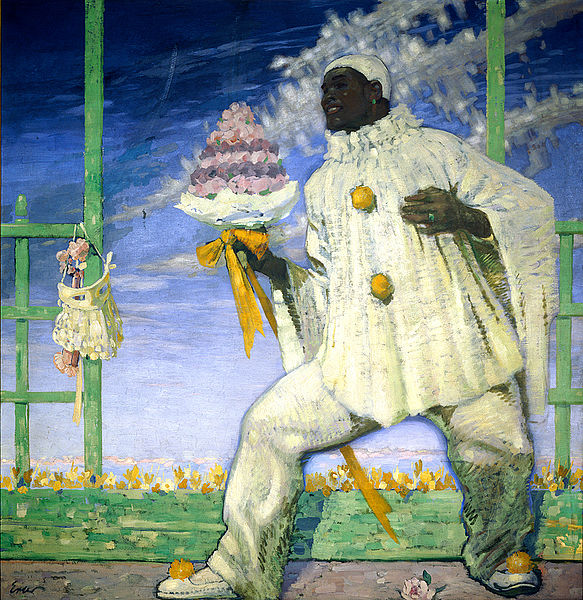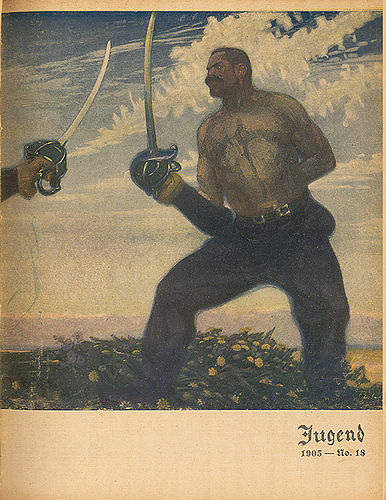
Provenance
1904 delivered by the artist to the Ninth Exhibition of the Berlin Secession as Der Fechter| until 1908 Fritz Erler, Munich | 1908 painted over as a commissioned work for the 1908 carnival celebrations of the Neuer Verein, Munich(Schwarzer Pierrot) | 1909 – at least until 1910 Moderne Galerie, Munich (Heinrich Thannhauser) | probably transferred to the Nationalgalerie, Berlin in 1952 | acquired by the Academy of the Arts, Berlin
Painter, graphic artist and set designer Fritz Erler was commissioned in 1908 to create two monumental works for the carnival celebrations of the Neuer Verein in Munich. In addition to the painting Der Goldregen, the approximately two metres by two metres Schwarze Pierrot was also created with a frame that Erler probably designed too.
The first indication of who owned the painting was provided by the magazine Die Kunst für Alle dating from 1909, in which the work is depicted with the note "Original in the possession of Moderne Kunsthandlung, Munich". The gallery was opened in 1904/05 by Franz Josef Brakl and Heinrich Thannhauser at Goethestraße 64. In addition to the older artist of the Münchner Künstlergenossenschaft, the first exhibition primarily showed members of the Munich Secession and members of Der Scholle. At the time of publication, the gallery was in liquidation. The art dealers each opened their own businesses: Brakl's Moderne Kunsthandlung and Galerie Thannhauser. Furthermore, from 1910 a permanent exhibition space was reserved for Erler's work at Moderne Galerie Heinrich Thannhauser in Munich. In 1910, the Pierrot is listed in the Moderne Galerie catalogue. Heinrich Thannhauser came from a Jewish family. He died of a stroke when fleeing National Socialism to Switzerland in 1934. His son Justin Thannhauser initially continued to run the business successfully with branches in Munich, Luzern and Berlin. He managed to flee in 1937, first to Paris and later to New York. However, the National Socialists confiscated all of the art holdings left behind. How long the Pierrot was in the possession of the Moderne Galerie is still unknown.
This transformation is remarkable. During the autopsy of the back of the painting, a Berlin Secession label was noticed. But Fritz Erler's painting Der Fechter (The Fencer) was listed in the catalogue of the Ninth Exhibition of the Berlin Secession in 1904 under Number 52. Soon after it was painted, all traces of the fencer were lost. The work was considered lost by researchers. It was only during the course of the provenance research that is was determined that Erler painted over the fencer, turning it into a black Pierrot.

In addition to technical examinations, a direct comparison of the painting with the depiction of the fencer handed down revealed formal similarities and clear correspondences: The way the two protagonists lunge immediately strikes the eye. The Pierrot seems to pause in a dance movement. The fencer, on the other hand, seems to take up a basic position with the same posture. The cloud formation in the background of the picture is also identical. Upon closer examination of the Pierrot painting, the observer can also see traces of a raised sabre in the left upper half of the picture. Der Fechter appears again on the title page of the second issue of the magazine Jugend - Münchner illustrierte Wochenschrift für Kunst und Leben in 1905. The fencer was subsequently destroyed ˗ probably because of negative criticism ˗ by the artist himself and the canvas was painted over with the Pierrot for the carnival celebrations.
Erler joined the artists' group Die Scholle as a founding member. His success as an official military artist and poster artist during the First World War and as a revered portrait artist during the National Socialist era led to a significant amount of his work being confiscated by the Allied Forces and in part destroyed.
A hanging label on the back of the work can also be seen. It notes: "Erler – 'Pierrot' – from Academy of the Arts - transferred 15/11/51". From 1952 to 1993, the painting was evidently at the Nationalgalerie der Staatlichen Museen zu Berlin (SMB). In 1993, the Nationalgalerie returned works to the Akademie, which were at one time handed over as loans or to be stored. In the "Loans from the Academy of the Arts – Compiled according to the Holdings Catalogue 19th Century Painting", Erler's work is listed under Number 6. The file of the SMB Central Archive Berlin documents a transfer of the painting to the Nationalgalerie in about 1952. It was probably found by the Magistrate of Greater Berlin in the course of clearing a building on Behringstraße (Baumschulenweg) and given to the Nationalgalerie for "safekeeping". Which building this might have been and whether it was a depot for artworks, a company building or a private house could not be found out.
It is a work full of contradictions. Further research is required.